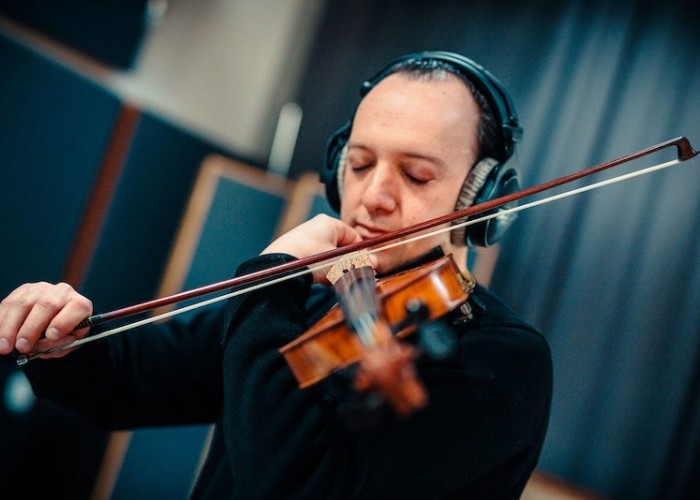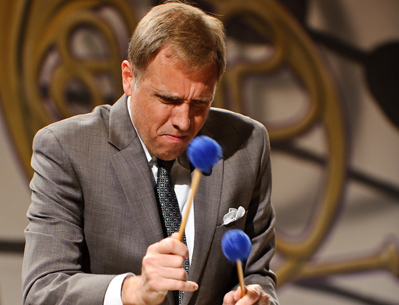Dec 9, 2025 12:28 PM
In Memoriam: Gordon Goodwin, 1954–2025
Gordon Goodwin, an award-winning saxophonist, pianist, bandleader, composer and arranger, died Dec. 8 in Los Angeles.…

Daniel Weltlinger plays his grandfather’s violin on Szolnok, an album detailing the journey Zoltan Fischmann undertook to escape oppression and religious intolerance during the 20th century.
(Photo: Courtesy Daniel Weltlinger)When Daniel Weltlinger was growing up in Sydney, Australia, he heard his grandfather Zoltan Fischmann’s stories of playing violin on the other side of the world. Weltlinger took up the instrument himself and has carried on the family tradition, which had become especially crucial since Fischmann’s death in 1998 at the age of 96.
But a greater challenge for Weltlinger came in relating through music his grandfather’s journeys across Europe and North Africa in the face of incredible turmoil. The narrative is told through compositions that comprise his quartet’s Szolnok (DMG/Rectify) and it’s done so using Fischmann’s fiddle.
“If you grow up with something, you don’t think too much about it, it’s just there,” Weltlinger said from his home in Berlin during a Skype interview. “And then I started thinking about the whole story, what it represented, started researching the history, trying to trace where the violin was and what kind of music might have occurred when it was in one place or another. Just trying to tell the story of the instrument, the instrument as protagonist. I still can’t quite grasp how this instrument survived so many things, but it did.”
The story could be a Hollywood epic: Fischmann, who later Anglicized his name, was born in 1902 in Szolnok, Hungary, where his classical violin prodigy brother died of the global flu virus of 1918. Fischmann also took up the instrument and played it in Vienna as the Austro-Hungarian Empire broke up at the end of World War I. But during the 1920s, he saw the rise of Adolf Hitler and ascending anti-Semitism, so Fischmann moved with some friends to France. Settling in Marseilles, he played folk and classical music while studying engineering. Fleeing advancing German armies at the onset of World War II, he escaped to Spain, was jailed in Algeria and later joined the British Army. He then helped liberate Paris and after the war moved to Morocco before immigrating to Australia. Each piece on Weltlinger’s album correlates to these episodes.
“As far as the global influences, that’s where the violin went,” Weltlinger said. “That’s the global influence: Hungarian riffs and a mix of Jewish, Hungarian and Eastern European sounding music is predominant throughout the album. But it’s influenced by where the instrument [went]—France, North Africa. When you stop and think about the whole story, it’s ludicrous. I don’t know how he got to North Africa. It’s crazy.”
Parts of Szolnok directly reference that tumult, such as Weltlinger’s dissonant phrasing on “1921.” The beat of “Le Chant Des Partisans” evokes a liberation army on the march, while phrases on “North Africa” reference Arabic scales. But ominous tones summoning visions of WWII also are set against the joy of playing Gypsy swing in French cafes and romantic odes that connect to the courtship between Weltlinger’s grandparents.
“The main point of this album is it has to do with continuation,” Weltlinger said. “This is positive because of where it ends up. But there’s a lot of darkness there, because of where my grandfather wound up and how he and the violin survived the second World War. I try to capture the time throughout the piece, so you’ve got the first track [‘Szolnok’] with open violin strings, the sound of a grandfather clock with the bass line and a melody I composed to characterize the instrument. Sometimes, it’s dark sounding; sometimes, it’s more lively. But every piece has to do with the context, it follows the chronology of the instrument.”
As Weltlinger holds up the violin to the computer screen, it appears to be in remarkable shape, especially considering all of the travails it encountered. But playing an instrument that had remained in its case for more than 20 years—and taking it to different climates—posed its own difficulties. Working around such challenges enhanced the results.
“This violin is very unusual, it’s really like a bass,” Weitlinger said. “It drives me crazy. You have to kill yourself to play anything on it. I listen afterwards and wonder how did this turn out the way it did? It wasn’t intended. Very subliminally and subconsciously, the violin seems to direct me in a certain way. Especially the second piece [‘Ernö’], which is difficult to play on any violin, but on this it’s crazy, because the strings are a bit higher, a bit more distance between the strings. So, to play double stops is a nightmare, but it’s good—it kicks you in the ass to play it.”
With renewed threats of rising authoritarianism and intolerance worldwide, Weltlinger is aware that his grandfather’s experiences resonate today. While Szolnok is, in some ways, a response to this tide, he emphasizes celebrating the music’s endurance.
“It’s not taking a side,” Weltlinger said. “It’s not an ideological thing, it’s not politics. It’s pure humanistic—artistic—and a gentle understanding of identity in the 21st century.” DB

Goodwin was one of the most acclaimed, successful and influential jazz musicians of his generation.
Dec 9, 2025 12:28 PM
Gordon Goodwin, an award-winning saxophonist, pianist, bandleader, composer and arranger, died Dec. 8 in Los Angeles.…

Belá Fleck during an interview with Fredrika Whitfield on CNN.
Jan 13, 2026 2:09 PM
The fallout from the renaming of the John F. Kennedy Center for the Performing Arts to include President Donald…

Flea has returned to his first instrument — the trumpet — and assembled a dream band of jazz musicians to record a new album.
Dec 2, 2025 2:01 AM
After a nearly five-decade career as one of his generation’s defining rock bassists, Flea has returned to his first…

Dec 11, 2025 11:00 AM
DownBeat presents a complete list of the 4-, 4½- and 5-star albums from 2025 in one convenient package. It’s a great…

Vibraphonist Chuck Redd found himself in the midst of a political firestorm after canceling his gig Dec. 24 at the newly renamed Trump Kennedy Center.
Jan 6, 2026 2:32 AM
The Board of Trustees at Washington, D.C.’s Kennedy Center for the Performing Arts voted on Dec. 18 to rename the…